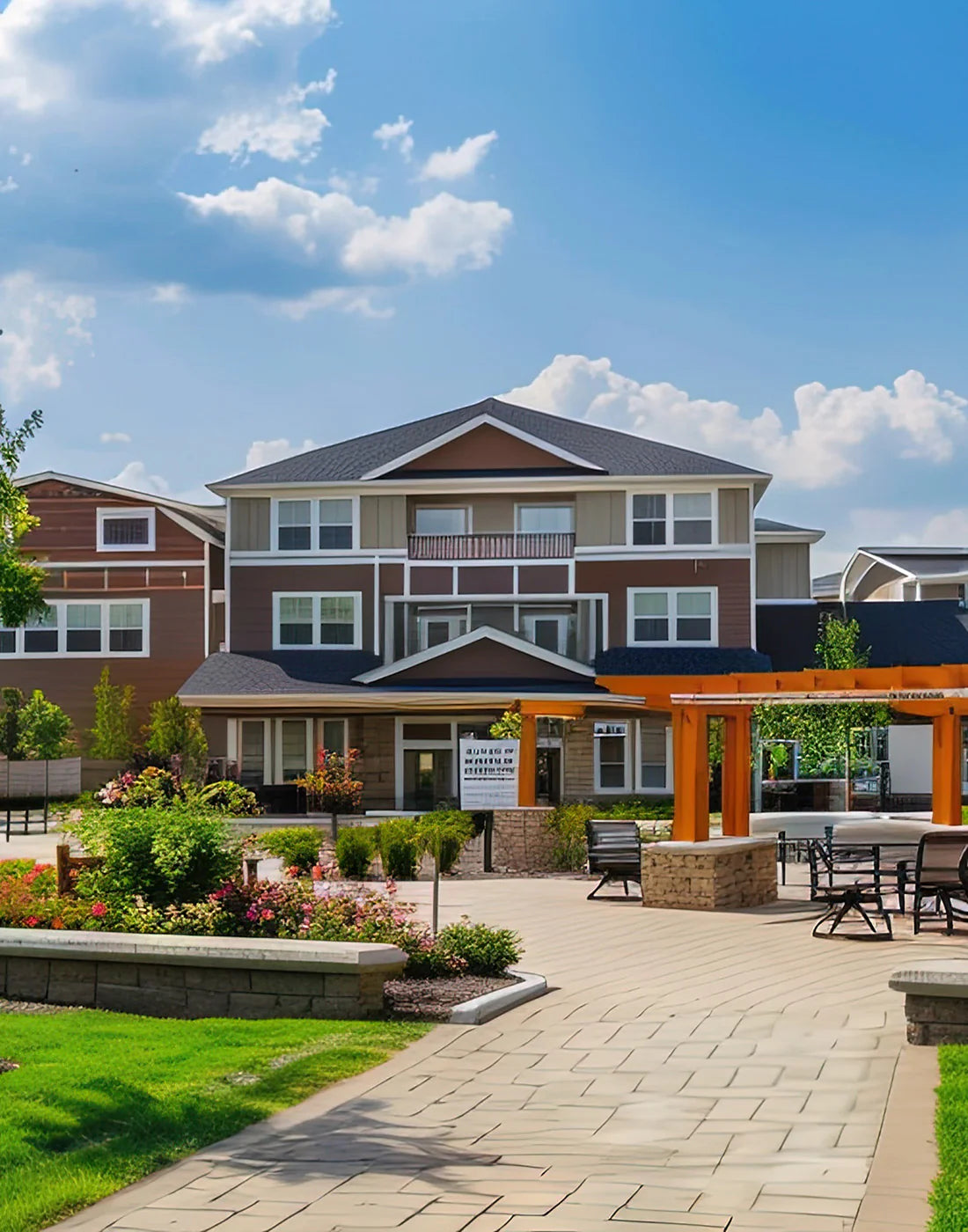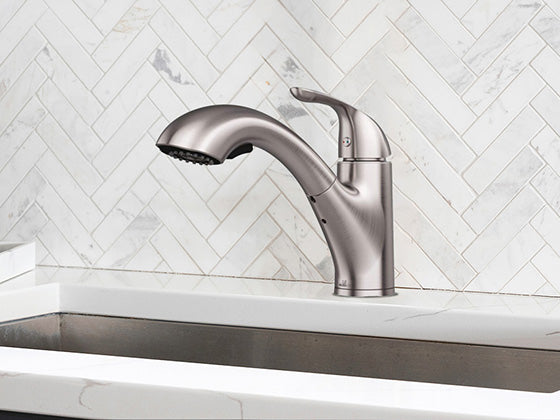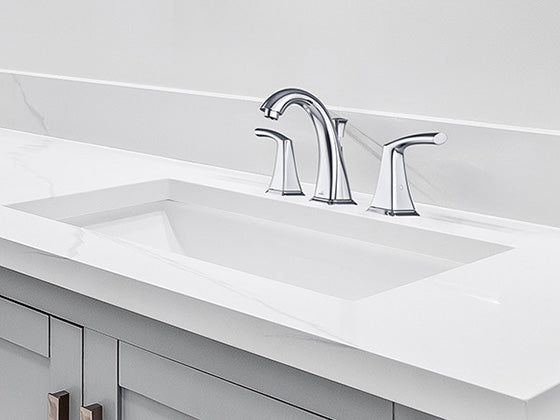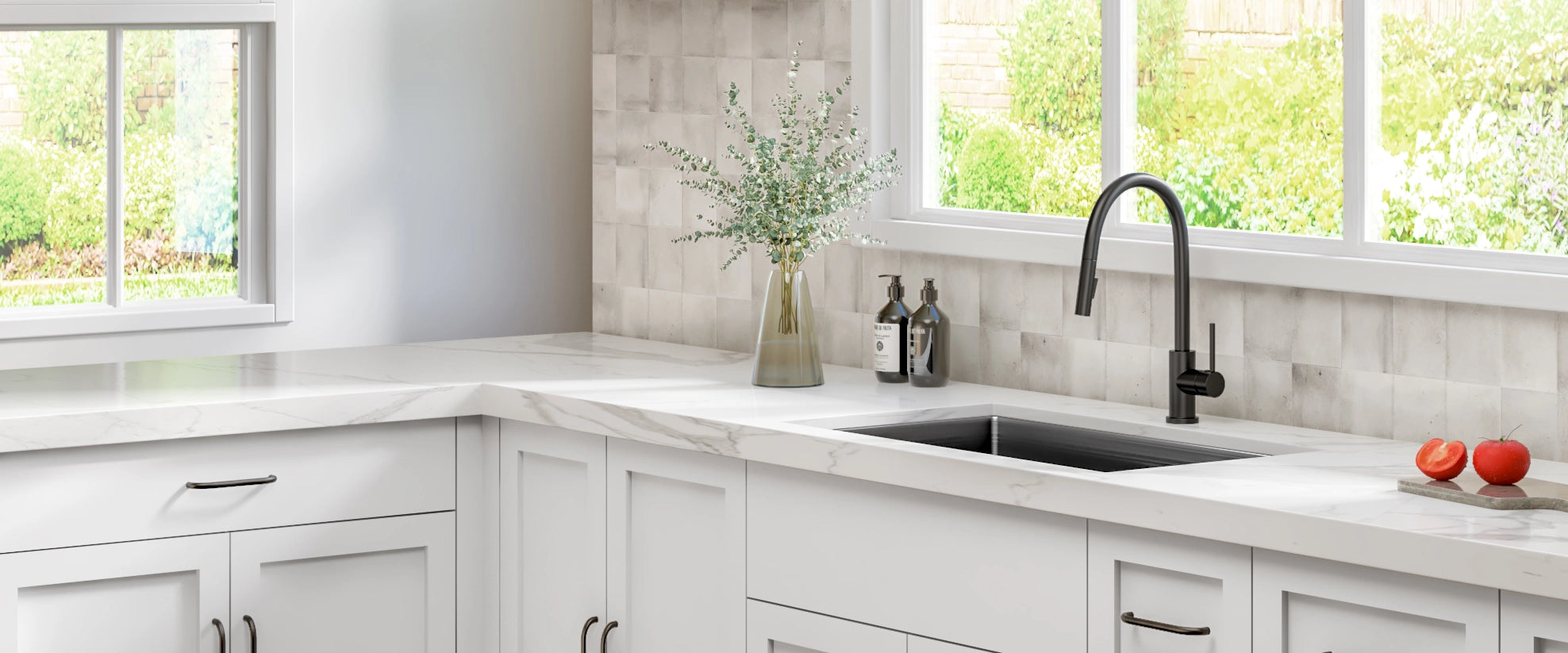Why is a stylish kitchen sink a great investment for multifamily builders?
Because compared to other fixtures, a kitchen sink is a small investment that can get huge results. The right sink can improve sales, command higher prices and boost your company’s reputation for creating gorgeous homes. But which of the endless models, materials or styles is the right model for your next build?
This comprehensive guide will show you how to choose the perfect sink to complement the kitchen design in your new build.
Chapter 1. Single vs. Double Kitchen Sinks
The first thing is to decide if you want a single or a double sink.
The number of basins in your sink makes the biggest difference to the resident’s daily lives. The number of bowls you want will affect what styles, materials, and colors will be available to choose from.
So which one is “the best”? Let us show you how to simplify your search so you get the perfect fit without wasted effort.

1.1 Why Single Kitchen Sinks Are More Common
single kitchen sink has one large bowl without a divider.
Single-bowl kitchen sinks are very popular because they go with the most designs and styles. Let’s dig a little deeper.
Pros:
- Maximum usable space inside the basin.
- Easily fit large cookware and pots.
- Less expensive option in many cases.
- Easier to keep clean.
- Flexible style that will suit many kitchen designs (can order in bulk and use the same basin for multiple projects).
Cons:
- Makes it hard to multitask; can only handle one job at a time.
- Some clients may prefer the versatility of a double kitchen sink.
- Only one person can use the sink at a time (hard to cook with family members).
Best for…
- Smaller kitchens and kitchenettes.
- Kitchens with smaller counter space near the sink.
- When the sink is in a corner with space on one side only.
- Commercial-style and industrial kitchen designs.
- Units with modern, minimalist, and modern chic interior design themes.
1.2 When Double Kitchen Sinks Are a Better Choice
Double bowl kitchen sinks have a divider to split the basin. Most of the time, it’s a 50/50 split.
However, asymmetrical designs can give your client a spacious bowl on one side with a sidecar for small jobs like washing hands. This split could be 60/40, 70/30, or even 80/20.


Let's dive in
Pros:
- More versatile than a single kitchen sink; can do multiple jobs at once.
- Makes it easier for multiple users to work side by side.
- Better option if your build has a garbage disposal; can use one basin to stack dishes and keep garbage disposal accessible.
- Uses less water if the user needs to fill the sink to soak dishes or thaw food.
Cons:
- Some asymmetrical sinks may have one bowl that goes unused because it’s too small to be practical.
- May not be available or practical for smaller sink sizes.
- Harder to keep clean.
- May cost more than a single kitchen sink.
Best for…
- Kitchens with garbage disposals.
- Larger kitchens.
- Homes and units built for larger families, (e.g. 3+ bed apartments).
- “Common area” kitchens and sink stations - like a break room or shared kitchen.
- When the project asks for a multitasking sink.
- Builds with traditional or Scandinavian designs, or where function is most important.
1.3 Standard Kitchen Sink Sizes: 25”-30” Kitchen Sinks
So what does this all mean for you?
Here’s a quick reference table for your next build
Now you know how many basins you need. But what about the sink itself?
That’s what we’ll cover in the next chapter. Keep reading…
Chapter 02. Mounting Options
Aside from picking the right size kitchen sink, choosing the right mounting option is the best way to make sure you’re making the best use of space in your kitchen design.
For some kitchens, maximizing counter space will be your number one priority. For others, it’s storage space below the sink.
How a sink sits in the cabinet makes a world of difference to both the kitchen’s looks and usability.
It also affects the cost of the sink, and difficulty of installation.
Let’s take a look at the four most common mounting options for kitchen sinks.
2.1 Undermount Kitchen Sink
An undermount kitchen sink sits below the countertop. It’s a low profile design that creates a seamless visual appearance in the sink area.
The basin will need to be installed with clips below the countertop and may need additional support in some cases.


Pros:
- No overhanging rim to take up counter space.
- Looks modern and high-end.
- Makes clean-up easy, as debris can be swept directly into the sink.
Cons:
- Installation is more complex, especially if you choose a heavy material like fireclay or cast iron.
- Needs a countertop with finished edges around the basin, which will add cost.
- Not recommended for laminate countertops
Best for…
- Kitchens with stone, granite, and quartz countertops.
- Modern, minimal, industrial, and high-end kitchens.
- Small kitchens that need a space-saving sink design.
2.2 Drop-In Kitchen Sinks
A drop-in kitchen sink, also called a top mount basin, has a rim that hangs over the edge of the countertop.
This is usually a traditional sink style, although modern materials can keep it from looking dated.


Pros:
- Fast and easy to install.
- Best for maximizing under sink storage space.
- Can look sleek and high-end in modern materials like stainless steel.
Cons:
- Overhanging lip eats up counter space.
- Rim can build up debris and mildew.
- Bulky materials like porcelain may look dated in a drop-in style.
Best for…
- Kitchens that need added storage more than clear counter space.
- Traditional, rustic, farmhouse or chateau chic interiors.
- Kitchen islands that need to make a big statement.
- Projects with a tight deadline or limited labor budget for installation.
2.3 Apron Front Kitchen Sinks
An apron front sink, also called a farmhouse sink, extends through the front edge of the countertop.
This eye-catching design has become trendy in recent years for its unique style.


Pros:
- Maximizes back-to-front basin space; great if you need a smaller sink width.
- Creates an interesting visual center point to your kitchen design.
- Can suit a wide variety of aesthetics.
Cons:
- Frequently need custom cabinetry (although a retrofit farmhouse sink may give you an effective alternative).
- Doesn’t work with all interiors.
- Complicated installation.
- Eats into under-sink storage.
Best for…
- Kitchens that need a space-saving basin.
- Rustic, country kitchen, midcentury, and retro designs.
- Larger kitchens meant for larger families (e.g. 3+ bedroom apartments).
- In stainless steel, go great with commercial-style and industrial designs.
2.4 Workstation Sinks
Workstation sinks> have a built-in lip to hold accessories like drop-in cutting boards. With drying racks and colanders
Some builders and contractors install undermount sinks with a positive reveal to achieve a similar effect. However, that leaves a groove that builds up debris and can be very hard to keep clean.


Pros:
- Maximizes the sink’s versatility without needing a double basin design.
- Accessories like drop-in cutting boards effectively extend counter space.
Cons:
- Accessories need occasional replacement.
- Built-in rim may build up debris (although less than a positive reveal undermount sink).
Best for…
- Smaller kitchens in higher priced locations.
- Kitchenettes.
- Modern, minimalist, industrial, and commercial-style designs.
Since some mounting styles take extra supports, it’s important to consider what material you want to use.
An undermount farmhouse sink in fireclay is going to be really heavy. That means taking the time and extra budget to build supports under the sink. Which also takes up storage space.
Sticking to lightweight but durable materials like stainless steel will make every install faster and easier, regardless of what mounting option you choose.
Now let’s take a look at how the shape of the sink will change the landscape.
Chapter 03. Sink Shapes
The shape of the kitchen sink will affect several factors:
- The aesthetic of the sink.
- How much usable space there is inside the basin.
- How easy it is to keep clean.
- Drainage.
Almost all kitchen sinks are rectangular or nearly rectangular. Choosing a standard sink shape will streamline your installation process, keeping multi-unit builds on schedule and on budget.
Circular, D-shaped, and asymmetrical styles can bring a unique touch to your kitchen design. But they also tend to be more expensive, harder to install, and require custom countertops.
So they’re usually not a profitable choice for multifamily builders. The cost and effort aren’t always offset by higher prices or rent.


Regardless of what style you choose, understanding sink radius will help you choose the most functional and comfortable basin for your prospective clients.
3.1 What Is Sink Radius?
Sink radius or corner radius refers to how curved the corners of a sink basin are.
Sink radius is measured with a square ruler. You can measure the curve of a corner by laying the square ruler on the basin so that it lines up with the sink’s flat edges.
Where the curve of the corner deviates from the ruler will give you the radius.
There are four main types. Let’s look at each one and break down a best use case for each.
3.2 Standard Radius
A standard radius is the most curved option for a standard basin shape. Of course, circular and D-shaped basins are the exception to the rule.
One of the most common sink styles, a standard radius is between 3” to 4”.
Pros:
- Easiest to keep clean.
- Curved edges and corners enhance drainage.
- Many homeowners prefer it for ease of use.
Cons:
- Least amount of usable space inside the basin.
- Curved edges can make it hard to stack dishes.
Best for…
- Large basins with plenty of space.
- Traditional kitchen designs.
- Multi-unit builds that need a neutral basin that will work in many different kitchens.
3.3 R-25 Radius
On the spectrum from most to least curve, the R-25 radius is next in line.
An R-25 sink radius measures 1”.
Pros:
- Good drainage and easy cleaning with a more modern aesthetic
- Best compromise between function and style.
Cons:
- Like the standard radius, curved edges may make it hard to stack dishes.
- Curved corners cut down usable space inside the basin.
Best for…
- Clients who want a high-end kitchen that’s also low maintenance.
3.4 R-15 Radius
An R-15 sink radius, also known as a tight radius, is the next step toward squared corners and straight edges.
A tight (R-15) sink radius measures ¾”.
Pros:
- Gives the look of a zero radius sink, but is easier to keep clean.
- Curve won’t interfere with stacking dishes.
- Increases usable basin space.
Cons:
- May accumulate some debris in the corners.
Best for…
- Professional-grade kitchens with commercial-style upgrades.
- Kitchen designs that need a high-end look with easy maintenance.
3.5 Zero Radius
Zero radius sinks have sharp corners and straight edges.
Pros:
- Maximum space of any design.
- Flat bottom is great for stacking dishes without anything falling over.
Cons:
- Tight corners can collect water and debris.
- Difficult to remove build-up from the corners once it collects.
Best for…
- Commercial-style and industrial kitchen designs.
- High-end kitchens.
Chapter 04. Getting the Best Sink for Your Build, Within Budget
Hopefully this guide has given you a solid starting point to find a basin style that will deliver ideal aesthetics and function for your build.
The next step is to find a kitchen sink wholesaler that has a wide variety of designs in the highest quality materials. That’s where we come in!
Our kitchen sink catalog allows you to select the style options you’re looking for so you can find what you want as fast as possible.
Not sure what your perfect kitchen sink might look like? Send us your specs and we’ll curate a list of options for your project. With dedicated professional support, we can set you up for ongoing care for all your builds.
We’ve got designs to suit every budget and design aesthetic.
We’re proud to offer standard models with ADA kitchen sinks to match, so you can get everything you need in one place.
Plus we offer:
- Discounts for commercial projects
- Guaranteed stock.
- Lifetime quality guarantee.
- Guaranteed pricing.
- 30 day money-back guarantee.
- Free shipping to most areas in the US.
- Delivery within 5 days or less anywhere in the US.
- Unlimited phone and email support.
We hope this guide will help you save time finding the right sink for your next project. We look forward to connecting you with sinks that will take your design to the next level!















